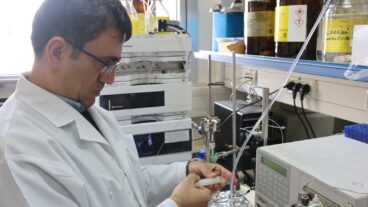Dr. Binyamin Reubinoff : This study shows for the first time that human embryonic stem cell-developed neural precursors can induce partial functional recovery in an experimental model of Parkinson’s disease.The prospect of using stem cells to treat Parkinson’s disease is one step closer after Israeli scientists announced that implanting human stem cells into the brains of rats has alleviated Parkinson’s-like symptoms.
According to Dr. Binyamin Reubinoff of the Hadassah Embryonic Stem Cell Research Center at Jerusalem’s Hadassah Medical Center, the research represents the first demonstration that human stem cells can replace damaged neurons in an animal model.
The news will bring new hope to the more than one million Americans suffering from the degenerative brain disease that currently has no permanent cure. Reubinoff presented a summary of an abstract that describes his study last week at the European Society of Human Reproduction and Embryology in Berlin, Germany.
Stem cells are the body’s building blocks that can develop into any part of the body, from limbs to blood to brain tissue, and can be obtained from donated embryos, either left over after fertility treatment, or from embryos deliberately cloned for therapeutic purposes. The progressive decline associated with Parkinson’s is caused by a loss of brain cells that produce a chemical called dopamine.
Reubinoff’s team manipulated human stem cells in the laboratory so that the ubiquitous cells were poised to develop into the specialist neurons that become depleted as Parkinson’s disease takes hold. These neurons were then transplanted into the brains of rats that had been engineered to show manifestations of the condition.
After the procedure, the rats’ symptoms were significantly reduced, Reubinoff told delegates at the annual meeting in Berlin. “This study shows for the first time that human embryonic stem cell-developed neural precursors can induce partial functional recovery in an experimental model of Parkinson’s disease,” he explained.
“We believe these observations are encouraging, and set the stage for future development that may eventually allow the use of embryonic stem cells for the treatment of Parkinson’s disease.”
Importantly, the study showed that the neural cells did not proliferate out of control. This concern was highlighted in a former clinical trial in the USA, which resulted in uncontrolled growth of stem cells that had been transplanted into the brains of volunteers with Parkinson’s disease. Disastrously, too much dopamine was produced in the brains of 15% of the participants, resulting in severe side effects such as jerking of the limbs.
Dr Miodrag Stojkovic, of Newcastle University’s Institute of Human Genetics, welcomed the results, but told The Guardian that caution must exercised when translating the results to humans.
“This use of human embryonic stem cells to improve the condition of rats with Parkinson’s is excellent news and underlines the huge potential of this kind of treatment. However, the development of treatments for humans is much more complicated, because of the difficulties in producing clinical-grade stem cells which are known to be free from contaminants such as viruses, and also the need to conduct lengthy clinical trials to ensure there are no adverse effects, such as the formation of tumors,” he said.
Reubinoff said further studies would be needed before the treatment could be given to humans because the safety of the treatment could not yet be assured.
“So far we have shown that the transplants can improve although not correct the behavior deficit,” he told ISRAEL21c. “We’ve accomplished only partial correction of behavior deficit of the rats. We would like to proceed to directing the development of the neuroprecursors toward generating the specific neurons that degenerate in Parkinson’s patients.”
Despite the questions raised, Reubinoff’s presentation was well received in Berlin. “It was highly appreciated. We actually received the Established Scientist prize from the selections committee,” he said.
Reubinoff, through his work at the Hadassah Embryonic Stem Cell Research Center, has been at the forefront of stem cell research. Hadassah, working together with Monash University in Australia and the National University of Singapore was the second group in the world to derive stem cells from human embryos. The researchers have succeeded in producing six of the human embryonic stem cell lines that are available for federally-funded research in the U.S.
Five of these lines are among the 12 lines that are currently distributed to U.S. researchers and are provided to more than 50 other laboratories around the world involved in stem cell research.
“After one to two weeks in culture, embryonic cells begin to differentiate into different kinds of stem cells, such as nerve and muscle cells,” Reubinoff said.
A graduate of Hadassah Medical School, and trained in obstetrics and gynocology, Reubinoff earned a M. Science degree (summa cum laude) in neurobiology and completed a PhD in biology in Australia. He’s also involved in Hadasit Medical Research Services and Development – which promotes and markets the intellectual property generated by the Hadassah Medical Organization.
In May, Hadasit President and CEO Dr. Raphael Hofstein, President and CEO announced the development of Reubinoff’s protocol utilizing stem cells lines to generate dopaminergic neurons. When injected into the brain of Parkinson’s disease patients, these neurons will replace damaged cells and are expected to reduce the diseases’ debilitating symptoms.
According to Robin Elliott, Executive Director of the Parkinson’s Disease
Foundation: “In the long term, this protocol could represent a potentially magical approach to the treatment of Parkinson’s and other debilitating human diseases.”
Reubinoff’s successful research has prompted Hadasit to set up together with the Singapore-based concern ESI, a new Israeli company called Cell Cure, that focuses on devices for the treatment of Parkinson?s and other diseases.
“CellCure was established to take the platform and develop it further toward clinical applications,” said Reubinoff.
“The best hope we have for Parkinson’s disease is stem cells. We must move past the early stages of development so that we can start helping people with this disease,” said. Hofstein.












